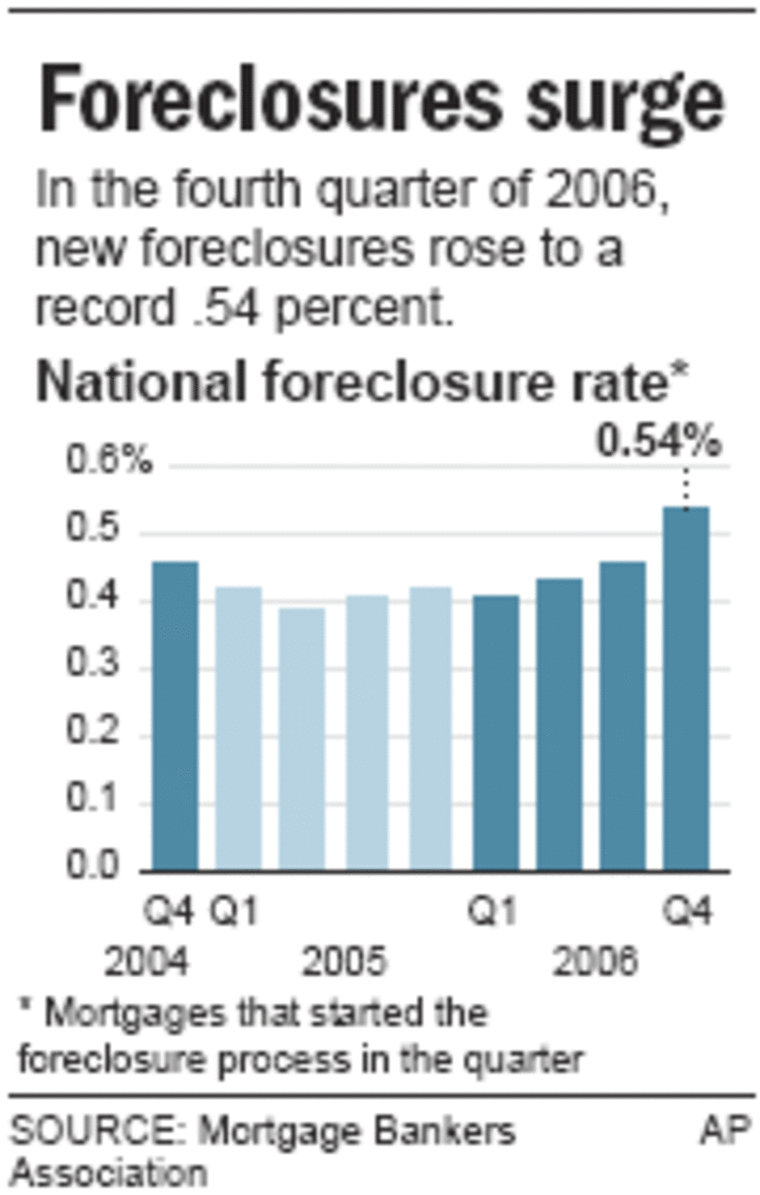Late mortgage payments shot up to a 3½-year high in the final quarter of last year and new foreclosures surged to record levels as borrowers with tarnished credit histories had trouble keeping up with monthly payments.
The Mortgage Bankers Association, in its quarterly snapshot of the mortgage market released Tuesday, reported the percentage of payments that were 30 or more days past due for all loans tracked jumped to 4.95 percent in the October-to-December quarter.
That marked a sharp rise from the third-quarter’s delinquency rate of 4.67 percent and was the worst showing since the spring of 2003, when the late-payment rate climbed to 4.97 percent.
The association’s survey covers 43.5 million loans.
The latest snapshot of the mortgage market stoked Wall Street investors’ worries about troubles facing “subprime” lenders who make loans to people with poor credit. The Dow Jones industrials tumbled 242.66 points.
The percentage of mortgages that started the foreclosure process in the final quarter of last year rose to 0.54 percent, a record high. The previous high, 0.50 percent, occurred in the second quarter of 2002 as the economy was recovering from the blows of the 2001 recession.
Delinquency and foreclosure rates were considerably higher for higher-risk subprime borrowers, especially those with adjustable-rate mortgages.

Lenders to subprime borrowers — people with blemished credit histories — have been battered. Rising interest rates and weak home prices have made it increasingly difficult for these borrowers — especially those with adjustable-rate mortgages — to keep up with their payments. Delinquencies and foreclosures in the subprime mortgage market are spiking.
The late-payment rate for all subprime loans jumped to 13.33 percent in the fourth quarter, up from 12.56 percent in the prior period and the highest in four years. The delinquency rate for subprime borrowers with adjustable-rate mortgages was even higher — 14.44 percent, also the highest in four years.
“Unfortunately, it appears delinquency rates will likely worsen before they improve,” said Gina Martin, economist at Wachovia Corp. Economics Group.
The rate of all subprime loans starting the foreclosure process at the end of last year was 2 percent, the highest in three years. The percentage of subprime adjustable-rate mortgages entering foreclosure soared to 2.70 percent, the second-highest on record.
Doug Duncan, the mortgage association’s chief economist, suggested that borrowers having difficulties making payments contact their lenders as soon as possible to work together on the problem. “It is in everyone’s interest to keep the homeowner in their home paying their bills on time,” he said.
Mounting concerns about risky mortgages have been making investors jittery. Those fears contributed to a worldwide stock meltdown on Feb. 27, where the Dow Jones industrials suffered a 416-point plunge.
Worried about defaults on high-risk mortgages, federal bank regulators earlier this month called on lenders to use caution in making subprime loans and strictly evaluate borrowers’ ability to repay them.
New Century Financial Corp., which was the nation’s second-largest subprime mortgage maker, is scrambling to stay afloat after all its bank lenders cut off funding or informed the company of their intent to do so because of its failure to make payments. The Irvine, Calif.-based company already has stopped accepting all new loan applications.